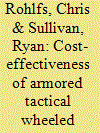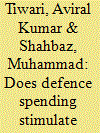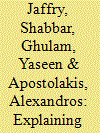| Srl | Item |
| 1 |
ID:
121745


|
|
|
|
|
| Publication |
2013.
|
| Summary/Abstract |
This study uses for official use only data on US military operations to evaluate the large-scale Army policies to replace relatively light Type 1 tactical wheeled vehicles (TWVs) with more heavily protected Type 2 variants and later to replace Type 2s with more heavily protected Type 3s. We find that Type 2 TWVs reduced fatalities at $1.1 million-$24.6 million per life saved for infantry units, with our preferred cost estimates falling below the $7.5?million cost-effectiveness threshold, and did not reduce fatalities for administrative and support units. We find that replacing Type 2 with Type 3 TWVs did not appreciably reduce fatalities and was not cost-effective.
|
|
|
|
|
|
|
|
|
|
|
|
|
|
|
|
| 2 |
ID:
121748


|
|
|
|
|
| Publication |
2013.
|
| Summary/Abstract |
This study reinvestigates the effect of defence spending on economic growth using Zivot and Andrews and Lee and Strazicich, structural unit root tests and the autoregressive distributed lag bounds testing approach to cointegration in augmented version of Keynesian model for India. Study confirmed long run relationship among variables studied show that economic growth is positively affected by defence spending (also negative impact after a threshold point), investment and trade openness while negatively by interest rate. Granger causality analysis revealed bidirectional causal relationship between defence spending and economic growth as probed by variance decomposition approach.
|
|
|
|
|
|
|
|
|
|
|
|
|
|
|
|
| 3 |
ID:
121747


|
|
|
|
|
| Publication |
2013.
|
| Summary/Abstract |
The Royal Navy (RN) is striving to achieve the right manpower mix through improved retention levels. This paper analyses the ratings' exit patterns from the RN using a hazard regression framework. We hypothesise that similar to civilian workers, job transition decisions of the RN ratings are dependent upon alternative job availability and macroeconomic conditions. In addition, working conditions, gender and skill mix, family commitments and promotion prospects in the Navy influence their decisions to leave early. We estimate the unemployment elasticity for males to be -0.65 (female -0.51), which is high, compared to the elasticity reported for the US Navy. The civilian wage is positively related to exit probability from the RN. Overall, married ratings are less likely to exit as compared to their unmarried counterparts, but married female ratings are 88% more likely to leave early as compared to unmarried females in the Navy. Promotion to higher ranks reduces the probability of early exists.
|
|
|
|
|
|
|
|
|
|
|
|
|
|
|
|
| 4 |
ID:
121746


|
|
|
|
|
| Publication |
2013.
|
| Summary/Abstract |
This article aims to analyse the sources of terrorist financing of the Euskadi Ta Askatasuna (ETA). It takes into account the network of entities that, under the leadership and oversight of ETA, have developed the political, economic, cultural, support and propaganda agenda of their terrorist project. This study focuses, in particular, on the periods 1993-2002 and 2003-2010, to observe the changes in the financing of terrorism after the outlawing of Batasuna, ETA's political wing. The results show the significant role of public subsidies in finance the terrorist network. It also proves that the outlawing of Batasuna caused a major change in that funding.
|
|
|
|
|
|
|
|
|
|
|
|
|
|
|
|